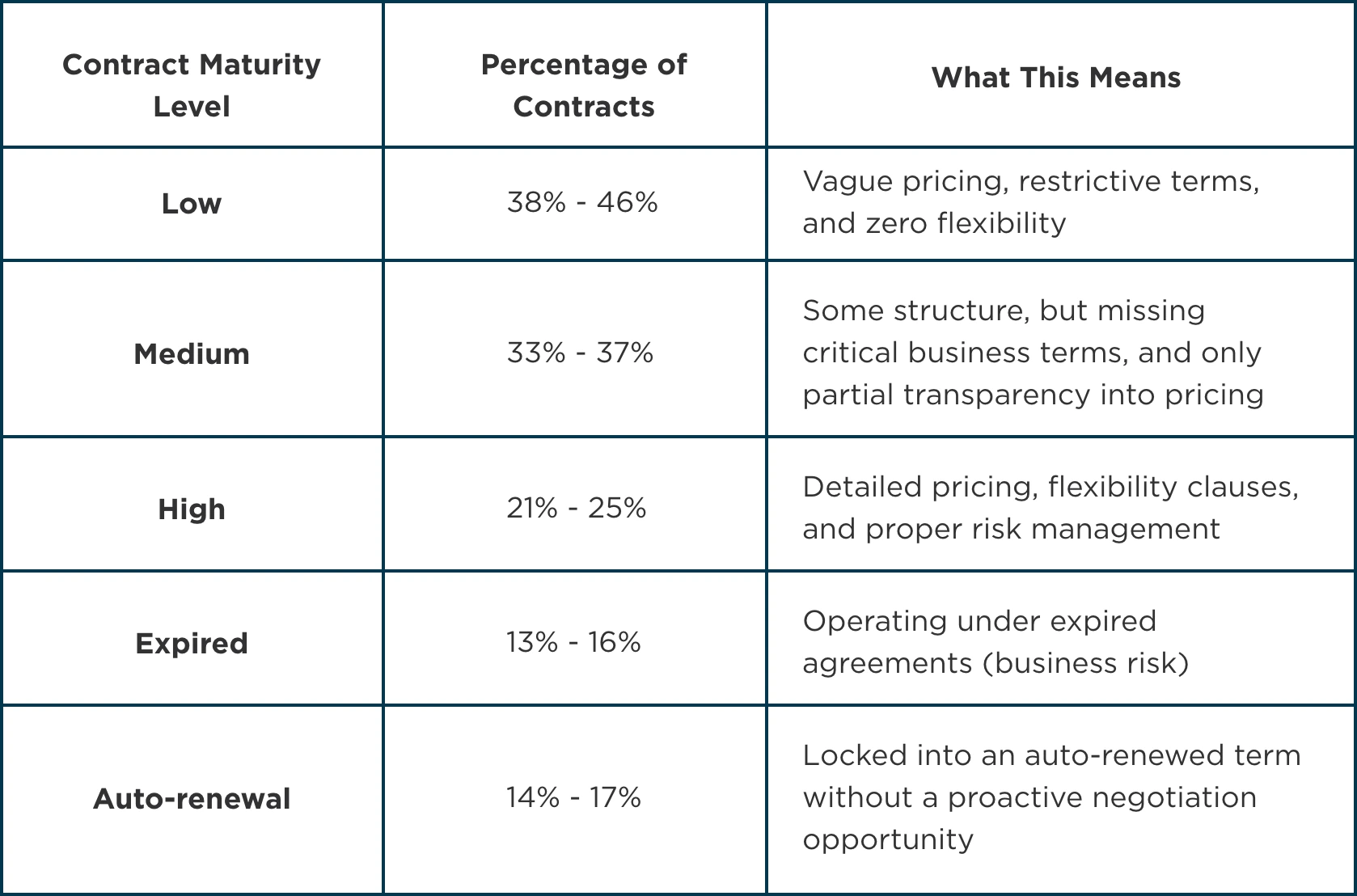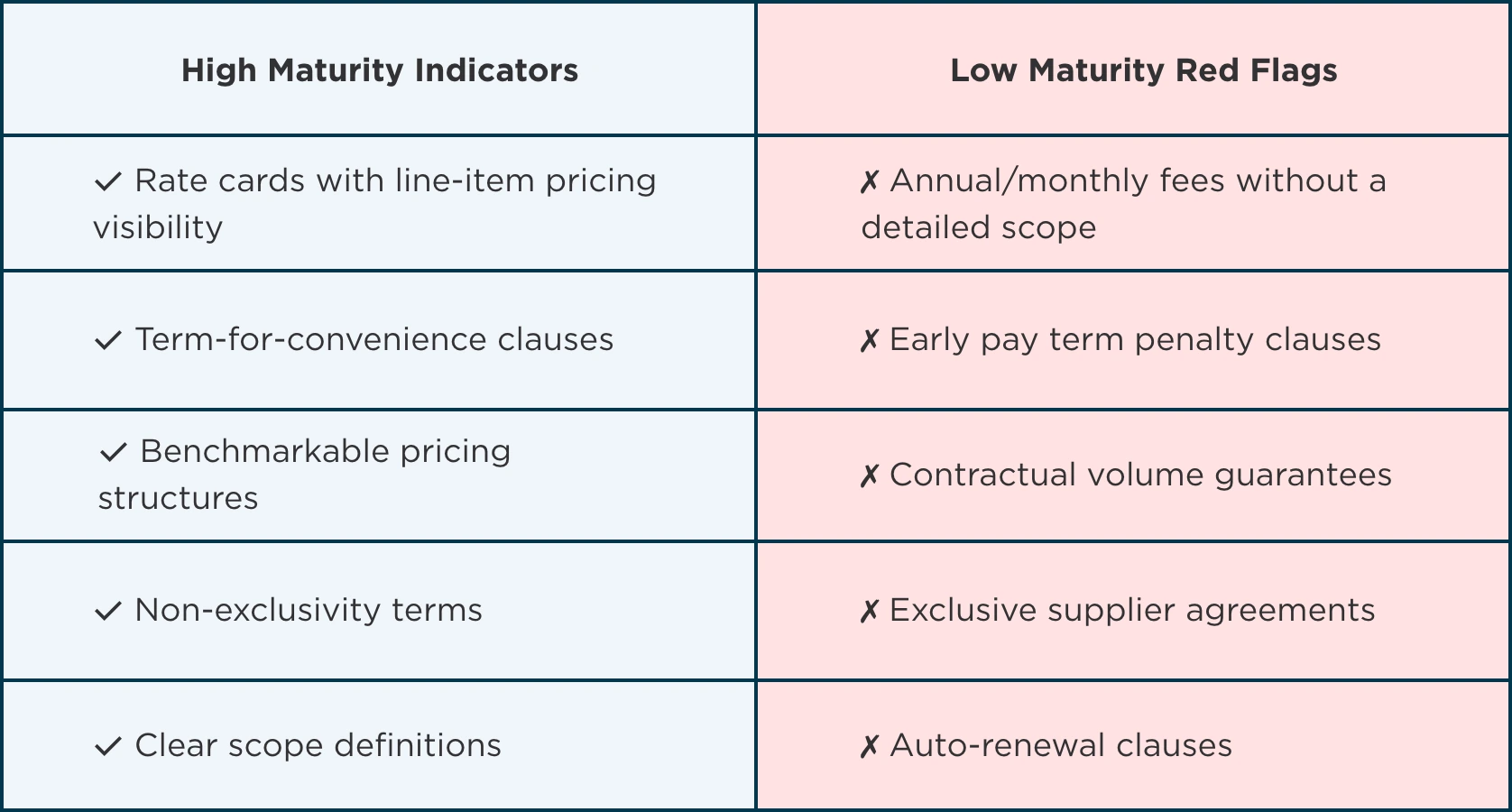We’ve all been here.
Your board members are asking tough questions, your teams are scrambling to find savings, and meanwhile, you’re locked into contracts that seemed reasonable two years ago, but they now feel like cement shoes on the feet of your profitability.
You’re in an executive meeting and a small bead of sweat is running down the middle of your back. You wonder — where is all the money going?
With shifting tariffs, increasing inflation, and constant supply chain disruptions, the contracts you signed during “stable” times are now working against you. It’s time to ask: do your current contracts allow you the flexibility to withstand whatever is coming next?
After analyzing over 6,000 contracts annually, across industries, we’ve found that most organizations are unknowingly bound by low-maturity agreements. The costs in these contracts are often 8%–12% higher than necessary and offer little in the way of flexibility or risk mitigation. While some agreements provide the transparency, control, and agility needed in today’s volatile market, many quietly undermine business strategies while inflating costs.
The Contract Reality Check: Our Analysis and Findings
Through our Mutual Value Assessments, we conduct comprehensive Contract Maturity and Contract Term Analysis. Here’s what we consistently discover across industries:

How we determine contract maturity:
While most organizations have the right spend amount under contracts, the contracts themselves are poorly managed. Close to 80% lack the business terms and pricing visibility needed to effectively manage supplier relationships or negotiate best-in-class pricing. Some of the causes include:
- Storage & Access: Offline – out of mind. Contracts stored offline create version control chaos and missed renewal opportunities
- Reactive Management: Last-minute renewals give all leverage to suppliers; expired contracts create business risk.
- Legal-First Approach: Focus on legal risk over business terms leaves 80% of contracts without adequate pricing visibility.
- Scope Control through Pricing Visibility: Without detailed cost breakdowns, benchmarking, and pricing visibility against scope, future negotiations become impossible.
- SLA Gaps: Missing service level agreements with associated penalties create unmanaged business risk.
- Exit Flexibility: The inability to exit contracts early reduces business agility in volatile markets.
Why Improving the Contracting Process Matters
A mature contracting process can serve as a strategic lever, giving your organization greater control, flexibility, and cost visibility across your supplier landscape.
Control and Flexibility
Proactive contract planning is essential to maintaining leverage at the negotiation table. But too often, organizations are caught off guard by contract expiration dates, leading to reactive renewals that favor suppliers. With proper planning, you can ask key strategic questions in advance:
- Do I want to remain with the incumbent Provider?
- Are there alternative providers that can be utilized for those services?
- Is there a Supplier/Scope optimization that can be applied through a supplier consolidation strategy?
- Is a Direct negotiation or an RFP the best approach?
These questions can only be answered effectively when you have enough lead time before a contract expires. Without it, the negotiation window closes, and leverage shifts to the supplier.
Flexibility should also be built into the contracts themselves. Clauses like termination for convenience and non-exclusivity allow organizations to adapt to inflation, tariffs, and other disruptions. In today’s volatile market, inflexible contracts expose your business to unnecessary risk.
Auto-renewals, if unmanaged, can quietly bind your organization into another term — without the opportunity to reassess pricing or scope. We’ve seen many organizations fall into this trap due to a lack of contract visibility and alert systems.
Total Cost of Ownership
A good quality contract (High-Maturity-Contract) provides sufficient insights into scope and associated pricing, so that you always know what the cost for a scope or service should be. Those contracts provide rate cards, hourly rates, hourly rates by job-level, clearly defined markup percentages, or clearly defined discount rates. These contracts allow you to:
- Re-negotiate them, with the understanding of the component costs, when the scope or services change.
- Provide an accurate and detailed baseline to benchmark them against the industry.
- Manage and track services and potentially renegotiate, reduce, and eliminate scope, if services that are paid for are not being used.
- Manage, track, and enforce Service Levels.
The more insight you have into your contracts, the better positioned you are to control spend, reduce risk, and manage your supply chain effectively.
How LogicSource Helps Clients to Improve on Contract Maturity
Every category of spend has different requirements regarding what is critically important to include within the contract. LogicSource has built an extensive catalog of key business requirements and pricing approaches by category and associated scope level to ensure that contracts are structured optimally to ensure transparency and optimal alignment of expectations.
The LSI Partnership brings a combination of dedicated resources, shared category experts, and enabling technology to fully manage indirect spend and assure optimal supplier contracts are put in place for (1) inclusion of key business terms critical to categories; (2) transparency of pricing structures; (3) automate alerts of contract expirations to assure active management. Dedicated resources who know the client’s needs, key risks, legal terms, and goals and objectives ensure that contracts are aligned with client expectations.
LogicSource’s team of 180+ category experts has developed best-practice contracting frameworks tailored to each category and industry, ensuring that client agreements are structured for maximum value and flexibility. These standards are embedded within our OneMarket Contracts module, which centralizes all contracts in a single repository, complete with key metadata and robust reporting capabilities for better visibility and control.
What Contract Maturity Delivers to Your Business
Any effective Contract Maturity initiative must begin with real data — not assumptions. You need a clear view of your current state through category-level market intelligence, full contract analysis across indirect spend, and benchmarks from similar organizations. Visibility into procurement and contract policies is equally essential. This foundation sets the baseline for measuring improvement and sustaining progress over time.
While these steps are critical, building a world-class contract management program requires time, investment, and alignment from senior leadership. It demands enhanced policies, cross-functional buy-in, and strong influence across the business.
- Mitigate risk to your business.
- Provides Flexibility and Leverage during times of Tariffs and Inflationary conditions, thus reducing their impact.
- Take control of your spend
- Proactively manage and adjust usage and reduce/eliminate waste
- Proactively adjust the scope as needed, and adjust associated costs, at any time during your contract
- Achieve significant cost savings
The Path to Sustainable Value
Based on our experience, Contract Maturity can drive 8%–12% cost improvement across indirect spend, which typically accounts for 20% of a company’s revenue. That translates into a substantial financial impact.
While organizations can try to build these capabilities in-house, it’s important to ask whether your team has the time, expertise, and cross-functional reach to make it successful. Many organizations benefit from a partner who can accelerate progress and reduce execution risk.
Perhaps most importantly, organizations need to embrace a longer-term view of procurement transformation. Organizations can certainly capture rapid savings opportunities, but the most significant and enduring value emerges from carefully orchestrated strategic programs that unfold over time.
Market pressures to reduce costs remain relentless, yet successful companies now recognize that the traditional playbook for achieving savings no longer works. Organizations that recognize this shift and adapt their approach accordingly will discover opportunities that their competitors miss – not just in 2025, but well into the future.









